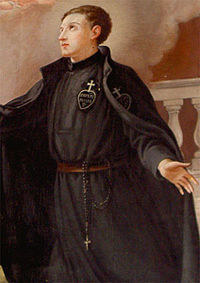Gabriel of Our Lady of Sorrows
| Saint Gabriel of Our Lady of Sorrows | |
|---|---|

A depiction of Saint Gabriel of Our Lady of Sorrows wearing the Passionist Habit. The Passionist Sign, part of the Habit, is on his chest.
|
|
| Confessor | |
| Born |
March 1, 1838 Assisi, Papal States (now Italy) |
| Died | February 27, 1862 (aged 23) Isola del Gran Sasso, Kingdom of Italy |
| Venerated in | Roman Catholic Church |
| Beatified | May 31, 1908, Rome, Italy by Pope Pius X |
| Canonized | May 13, 1920, Rome, Italy by Pope Benedict XV |
| Major shrine | San Gabriele, Teramo, Abruzzi |
| Feast | February 27 for Traditional Roman Catholics |
| Attributes | Passionist Habit and Sign |
| Patronage | Students, Youth, Clerics, Seminarians, Abruzzi |
Saint Gabriel of Our Lady of Sorrows (born Francesco Possenti March 1, 1838 – February 27, 1862) was an Italian Passionist clerical student. Born to a professional family, he gave up ambitions of a secular career to enter the Passionist Congregation. His life in the monastery was not extraordinary, yet he followed the rule of the congregation perfectly and was known for his great devotion to the sorrows of the Virgin Mary. He died from tuberculosis at the age of 23 in Isola del Gran Sasso, in the province of Teramo. He was canonized by Pope Benedict XV in 1920.
Francesco Possenti was born on March 1, 1838, in Assisi Italy, the eleventh of thirteen children born to his mother, Agnes, and his father, Sante. The family were then resident in the town of Assisi where Sante worked for the local government. Possenti was baptised on the day of his birth in the same font in which Saint Francis of Assisi had been baptised. Shortly after Francis' birth Sante Possenti was transferred to a post at Montalta and thence to Spoleto where, in 1841, he was appointed legal assessor. In Spoleto the family was struck with a number of bereavements: the deaths of a baby girl, Rosa, in December 1841; of seven-year-old Adele in January 1842; and of Francis’ mother, Agnes, in 1842.
As a child and young man, Francis Possenti was well liked by his peers and had a reputation for great charity and piety. He was also known for the great care he took with regard to his appearance and would spend hours in preparing himself for parties. Francis could be a difficult child and was liable to bouts of anger. Francis was deeply involved with the social scene of Spoleto and soon earned for himself the nickname of "the dancer". He was a ladies man, and had several romantic involvements and on the night he left for the monastery there were still hopes that he might become engaged to a local girl. He was educated first by the Christian Brothers and then by the Jesuits in the town’s college and there excelled, particularly in Latin. In 1851 Francis became desperately ill and promised to enter religious life if he recovered. Once he had recovered, his promise was soon forgotten. The same thing happened when he narrowly escaped a stray bullet during a hunting expedition with friends. His brother Paul had died in 1848 and his brother Lawrence committed suicide in 1853. In 1853 Francis again fell ill, this time afflicted with a throat abscess. He attributed his healing to the recently beatified Andrew Bobola, SJ. Once more he had promised to enter religious life upon his recovery and this time actually set the process in motion. He applied to join the Jesuits, but for some unknown reason never proceeded. Tragedy struck again when his sister, Mary Louisa, who had cared for Francis after their mother’s death, died of cholera.
...
Wikipedia
